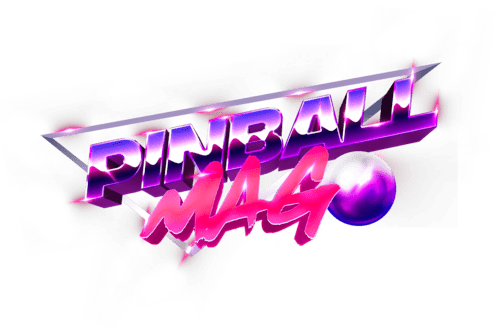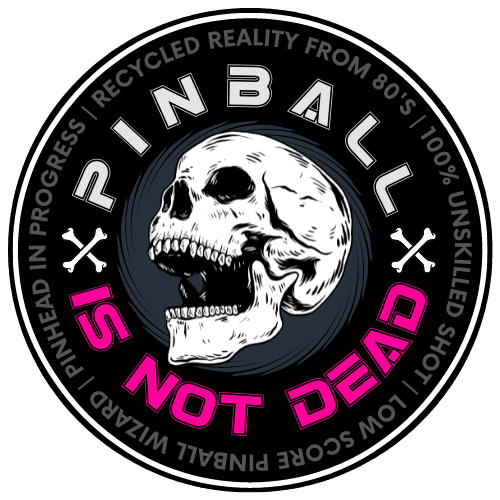What a character, dear Pinhead friends, what a character! Forget false modesty, John Popadiuk is one of those braggarts who bring it on so much that one hesitates to call them misunderstood visionaries or swindlers.
The designer has some great credentials in the 90s, but seems to be going through hell since the 2000s, and his clients with him. When the market crashed in the 2000s, most of the designers who wrote their names into pinball history made a wise choice to join Stern Pinball. They must have been bored for 10 years, but they kept the pot boiling.
John, on the other hand, thought outside the box. And it didn’t pay off for him or the market. Let’s break it down, starting at the beginning.
Sommaire
- 1 Even as a child, Popadiuk…
- 2 The Alice in Wonderland prototype
- 3 The Bally/Williams era: the springboard for Popadiuk
- 4 Good designers or good technicians at Williams?
- 5 Popadiuk’s legendary pinball machines
- 6 Pinball 2000: Star Wars Episode 1, The Phantom Menace
- 7 The 2000s: crossing the desert
- 8 Zidware: a manufacturer for an elite
- 9 Magic Girl, a beautiful promise
- 10 And the machine goes into overdrive
- 11 The end of Zidware
- 12 American Pinball’s rescue attempt
- 13 The debacle with deeproot
- 14 The responsibility of John Popadiuk in the deeproot case
- 15 John Popadiuk: a mixed bag
- 16 Sources for the article on John Popadiuk
Even as a child, Popadiuk…
All the facts described in this paragraph are taken from interviews that John Popadiuk gave.
As a teenager, John worked for what appears to be a Toronto-based operator, repairing pinball machines. At the age of 19, he wrote to Norm Clark, a designer at Bally’s. What he said in his letter is not known, but the guy invited him to take a tour of the factory. As he was driving him back to the airport, Clark offered him, at Popadiuk’s insistence, a job at the manufacturer. “I was useful [to the Bally team] from day one,” our John said with humility…

Specifically, he was a technician on the playfield design lab team. The “whitewood lab”, as he calls it. In passing, he mentions an interesting fact: in the 70s and 80s, the themes were chosen once the game mechanics were defined and the board was functional. The “hardware” part was involved earlier in the project, and was therefore more important.
Don’t tell us that today pinball themes are interchangeable. That was before. Nowadays, manufacturers usually negotiate the licenses and only then think about the table. The theme is central nowadays (and sometimes the only selling point), where it was incidental 40 years ago.
In short, Popadiuk studied with the greatest designers and engineers, Bally being at that time one of the two main players, together with Gottlieb.
The Alice in Wonderland prototype
Our character remained a technician during this period. Nevertheless, he got his hands on a prototype that didn’t give birth to anything but a life-size model.
We see some original features, without being able to say if they come from him or from his accomplice Mike Hanley:
- A flipper at the bottom of the left outlane, supposedly saving the ball in extremis?
- Ramps whose arrival seems to be bad, likely to break the flow or even to trap the ball
- A clock under the board, visible through a window, which seems to be more a toy than an underplayfield
John kept this fixation on Alice in Wonderland for years. It will reappear later in his projects, we will come back to it.
The Bally/Williams era: the springboard for Popadiuk
In 1988, Williams bought Bally, and John followed suit. The merger paid off for him as he became a game designer in the process. Unfortunately for him, his first project, Ice Castle, never made it to production. We haven’t found any pictures of the machine, and the reasons for its cancellation in May 1989 are not known to us.
He had to wait 5 more years for his first REAL pinball machine to be released: World Cup Soccer. Although it cannot be called a mythical table, it is still appreciated: No. 70 on pinside, WCS stands out for its ball-shaped half-sphere that turns on itself so quickly that it alters the ball’s trajectory when it comes into contact.
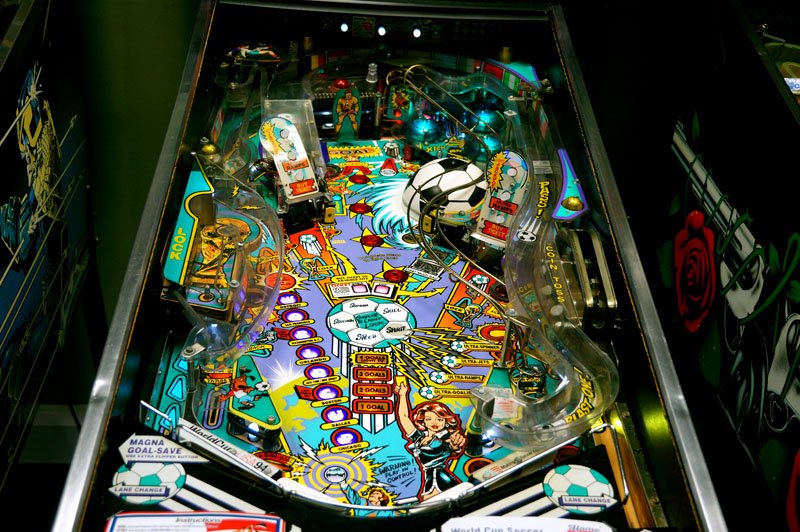

Add to that soccer cages in the background with a moving goalie in front, and finally a magnet placed just above the left flipper. Then you have the quintessential pinball game. Nice, simple, light code. Not enough to scream genius, but quite honorable.
Good designers or good technicians at Williams?
Most of the time, the discussions within the Pinball Mag. team are about the toys we buy (“have you seen my 0.5cm high mod bought in the US for $1000 including $900 for shipping ?”). But sometimes, we discuss intelligent things.
For example, there is a debate about the real genius of the designers from the 90s. The real cadors might be the techies and coders, more than the designers. In a 2012 interview, Popadiuk himself admitted that he was no longer sure who was behind a feature in Tales of the Arabian Nights (TOTAN), although he was pretty sure it wasn’t him. He explained that the role of a designer at that time was more like that of a shepherd leading his flock. A project manager, if you put aside the emphasis. Project managers don’t need to be the most creative, but the most organized and focused on the overall coherence and attentive to the specifications of course, Bally/Williams was not a philanthropic company.
For the Popadiuk successes of that time, the idea is even more relevant. What do we remember about World Cup Soccer, TOTAN or Theatre of Magic? Respectively the ball as explained above, the magic lamp and the Magic Trunk. The layout of the playfield sometimes leaves something to be desired, like this lamp placed in the center of the playfield on Tales of the Arabian Nights and hiding most of the objectives from the right flipper. The gameplay on WCS and ToM is a bit too often limited to aiming at the goalkeeper’s cage or the magic chest. And that ball is nice but underutilized.
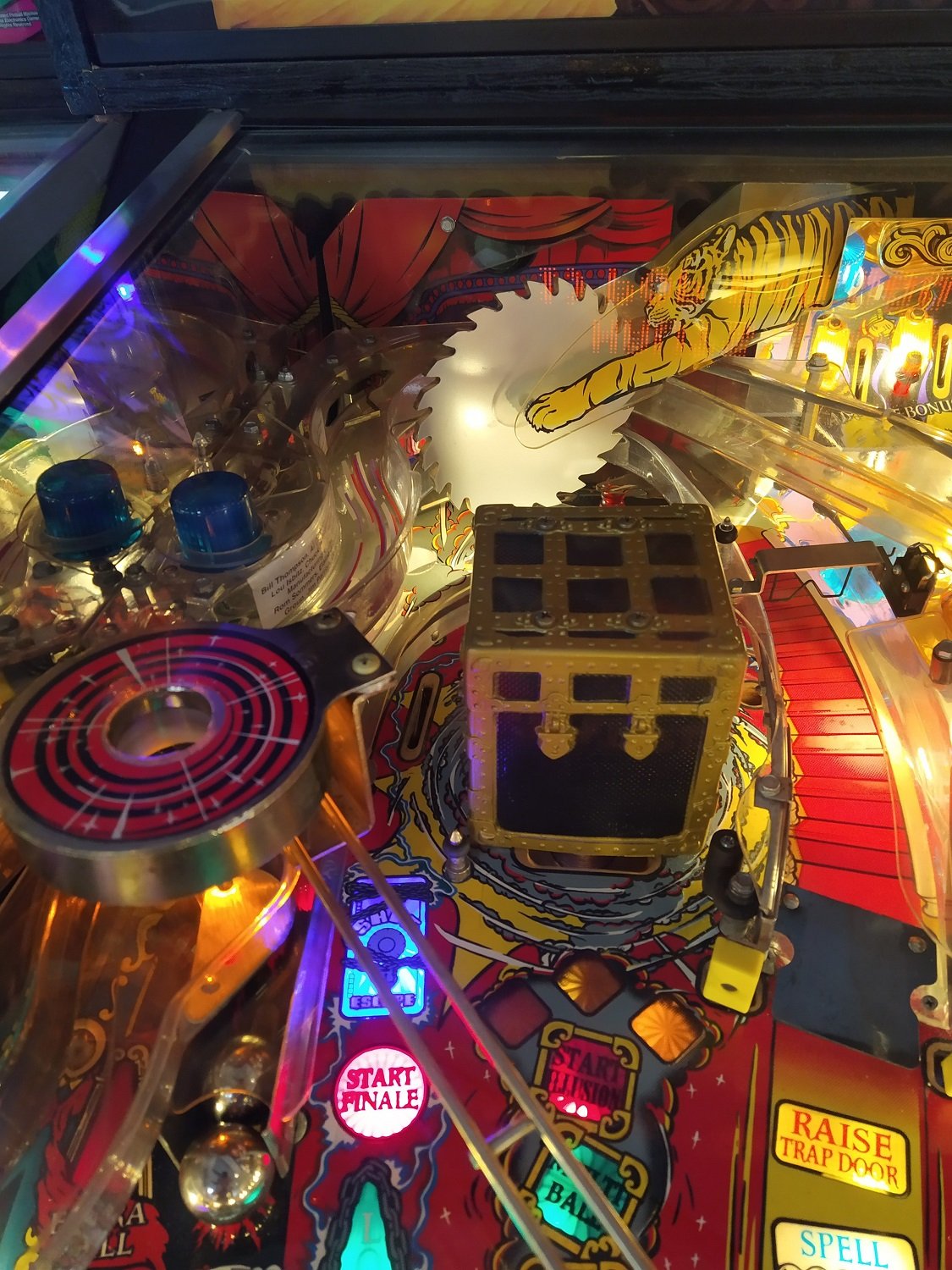



Besides, when you see how fast the pinball designers were releasing their machines in the 90’s, they couldn’t put their paws on every aspect of the gameplay as much as you’d like to think. We’ll come back to Popadiuk’s pace a little further down. So the toys, which often combined boldness and robustness, and to a lesser extent the code, were the charm of the machines of the great era. So it was a matter of technique and ingenuity. The goal was to use tricks to add magic to the playfield, at a lower cost and while hiding the strings. Constraint is fertile, as they say. It’s reminiscent of the special effects of silent movies, don’t you think?
Popadiuk’s legendary pinball machines
We’ve taken a little detour, let’s get back to the heart of the matter. What were these pinball machines that justify John Popadiuk’s entry into the Designers’ Hall of Fame?
- World Cup Soccer, 1994, 8,743 units produced
- Theatre of Magic, 1995, 8 441 units
- Tales of the Arabian Nights, 1996, 3,128 units
- Cirqus Voltaire, 1997, 2,704 units
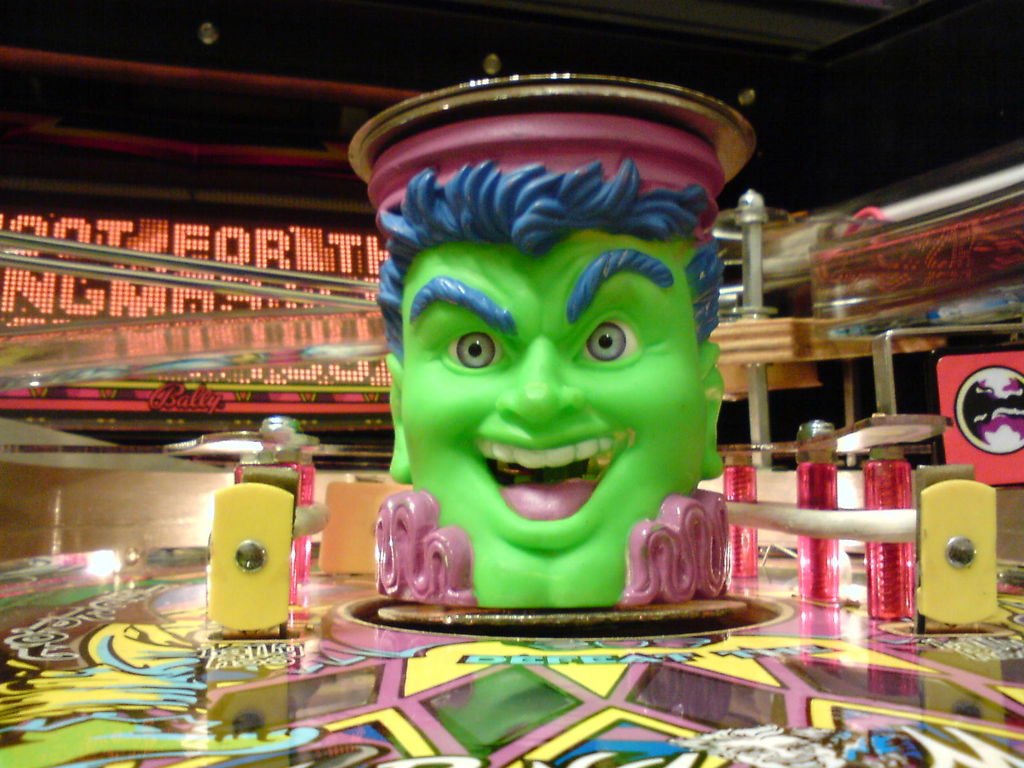

So Popadiuk’s memorable games were produced over 4 years, at a breakneck pace that no current designer could keep up. We’re not much, are we? The guy has worked all his life and the successes he is credited with are concentrated in less than half a decade.
That’s better than nothing, few can boast of having designed iconic objects. And every forty-something Pinhead has laid their hands on at least one of them. They are the quintessence of a time when machines were designed for exploitation, when catching the eye of the player was more important than keeping the ball in the air for more than a minute.
Pinball 2000: Star Wars Episode 1, The Phantom Menace
In the twilight of the Bally/Williams era, the idea of a pinball machine that converges with the video game was born: Pinball 2000. The subject deserves its own article, but remember that it was a computer, its screen with rather clever transparency effects, all in the box and with the electromechanical part of a pinball machine. A video is better than a long speech so here it is. The concept was brought by George Gomez and Pat Lawlor, probably the two greatest designers of the 90’s.
The initial idea of combining a computer and a pinball machine was in the making at Popadiuk. But there was a fundamental problem with this concept: the eyes cannot be on the monitor and the board at the same time. So it was two juxtaposed gameplays rather than a seamless, coherent experience. Moving the digital rendering to the playfield was the idea of Gomez and his engineer.
The Revenge from Mars pinball machine was released 6 months earlier than Star Wars’ one. John’s machine declined the concept without significantly changing the formula.
It was nevertheless a major commercial success for its time, with 5,100 units produced, far ahead of the scores of Monster Bash and Medieval Madness for example. Pinball 2000 did not succeed in saving pinball for all that, the production costs linked to the onboard computer being too high, but above all Williams’ strategy was no longer compatible with a fragile pinball business.
Today, this Star Wars pinball is not particularly popular. Perhaps this is due to the difficulty of replacing the computer components?
To sum up, Pinball 2000 was an important event in the history of pinball, but John Popadiuk was only a secondary player.
The 2000s: crossing the desert
As written in the introduction, many illustrious figures in the history of pinball had a serious hangover in the 2000s. The most talented or the most pragmatic joined Stern Pinball, the only important manufacturer still standing.
This was not the case for our Canadian, who felt like an entrepreneur. He started a business of illuminated signs, which soon failed.
He even collaborated with Zizzle, an electronic games company for children created in 2005 by Marc Rosenberg (the creator of Furby!) and disappeared in 2009. Nevertheless, Zizzle managed to acquire the rights to the Pirates of the Caribbean, SpongeBob and Marvel licenses.
Popadiuk designed 6 machines in this context, which are not very memorable. A toy is often simpler, lighter, smaller than its adult version, that is understood and understandable. You can’t judge this object with the same criteria as a bar pinball machine.
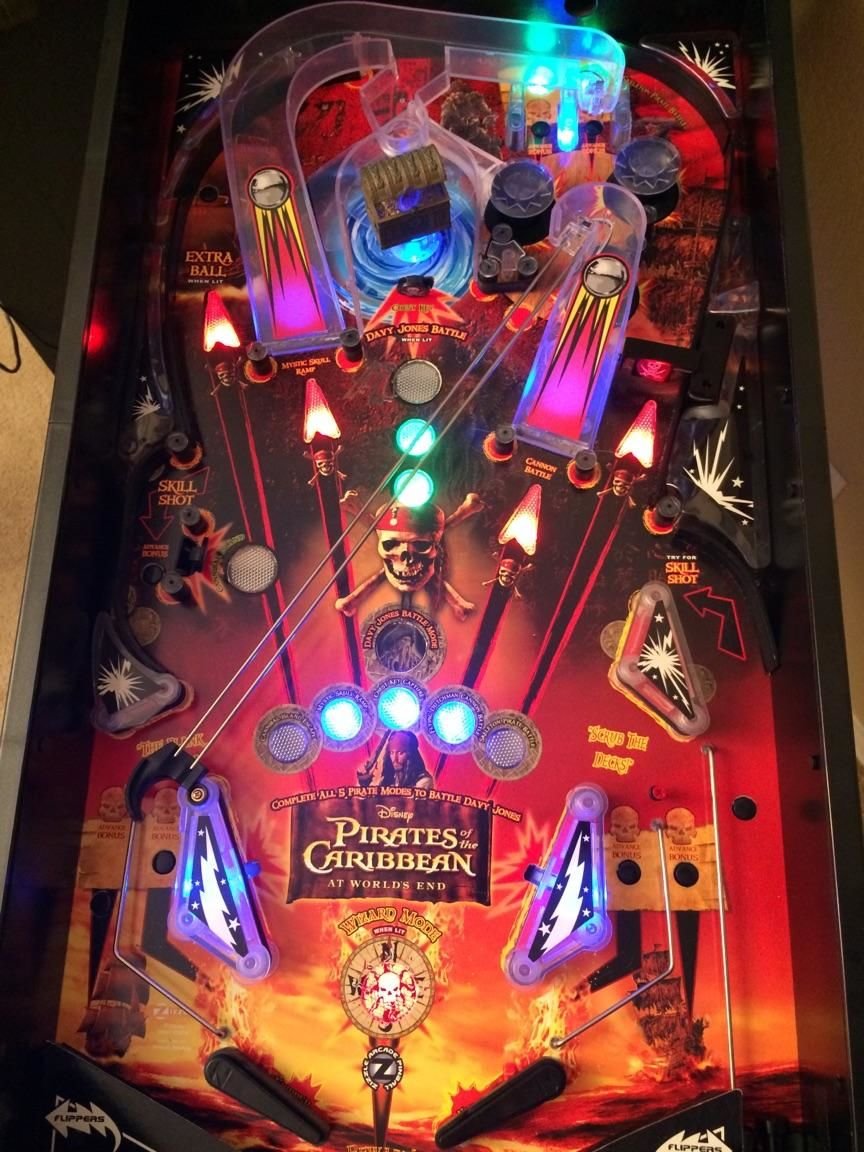

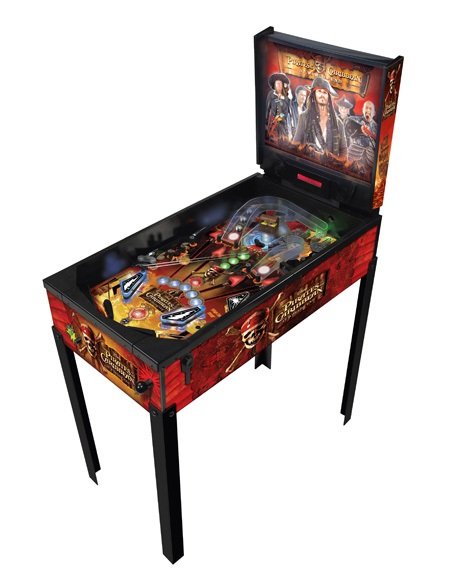

But the owners of the Zizzle mini-flippers complained about a cheap manufacture and a repetitive music that can’t be turned off. The code was light, no wonder. On the other hand, the layout of the playfields showed that Popadiuk still knew how to design a board, with constraints that are obviously very different from a full-size table.
After the closure of Zizzle, John developed 2 video games for iOS: Pinball Scrapbook and Pinball Wizard, of which we have not found any trace.
Zidware: a manufacturer for an elite
Popadiuk’s reputation earned him a request from wealthy Pinheads to design new machines for a select audience. The other designers would receive the same kind of offers, but he was available.


The siren song convinced him to found his own company, Zidware, in 2011, both a designer and manufacturer of pinball machines. The initial business plan was simple and was announced at the company’s inception: to market pinball machines in very limited series, at prices aimed solely at collectors.
This is where Magic Girl was born.
Magic Girl, a beautiful promise
Some people see a kinship with Theatre of Magic, but apart from the theme and sometimes the soundtrack, the set is very different in its layout, with the presence of a mini-platform and a screen at the bottom. The theme being similar, there are nevertheless elements that remind us of the filiation: rabbits, a chest, a feline… But a magic lamp that reminds rather Tales of the Arabian Nights and a green genie Cirqus Voltaire! Pinballboy sums it up this way: Magic Girl is the fruit of a night of love between these 3 pinballs. Well done!
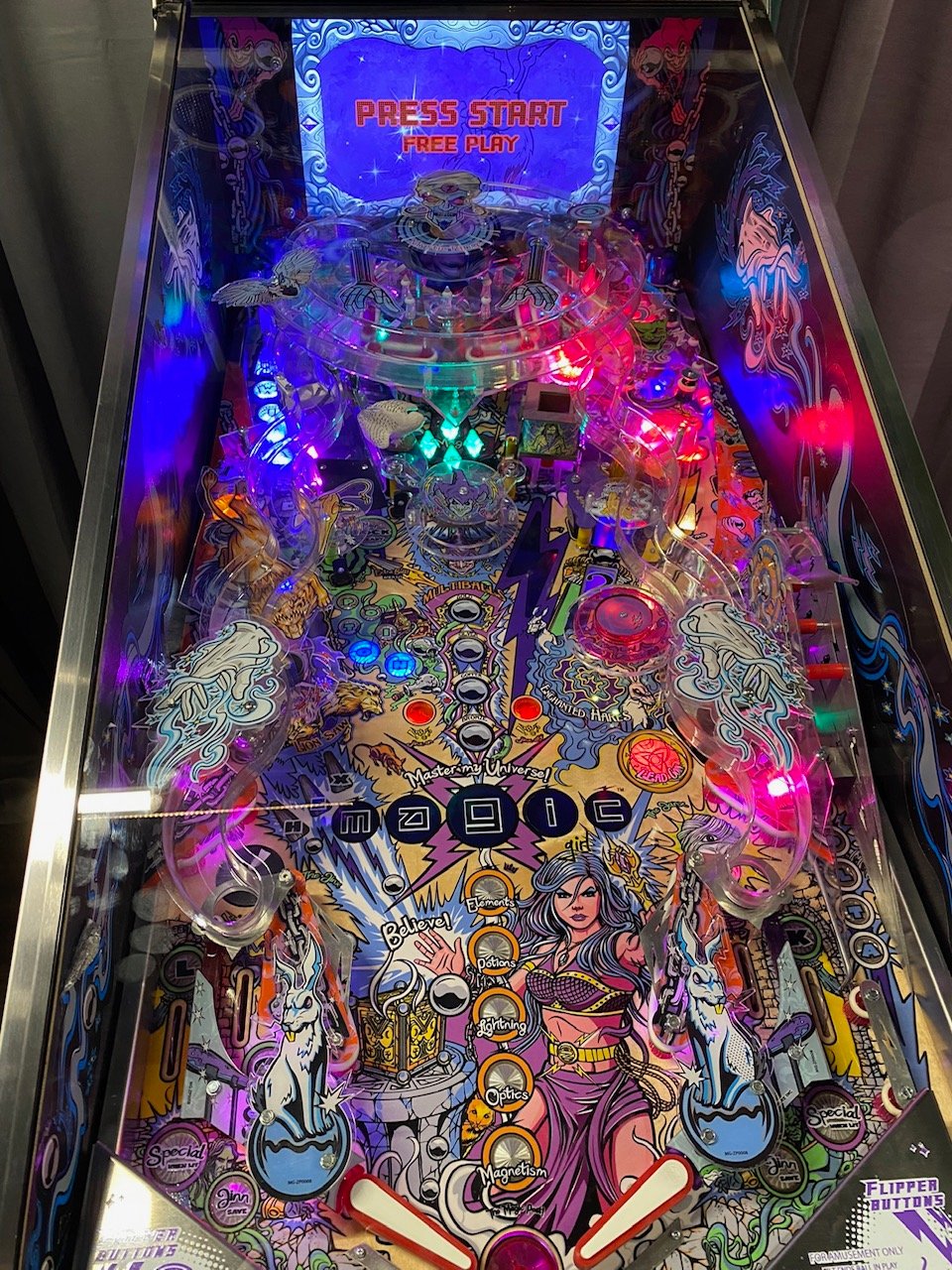

As soon as his company Zidware was created, Popadiuk announced the production of this pinball machine, at the mind-boggling price of $16,000, at a time when Stern Pinball machines did not exceed $6,000! Production was to be ultra-limited, less than 10 units, although the number continued to grow. With the influx of pre-orders, John P. couldn’t help but open the floodgates a bit. Indeed, to reserve a machine, a deposit was required, proof of the seriousness of the intention.
A few weeks after the commercial launch, Popadiuk announced about twenty finalized pre-orders, and about a hundred potential requests. At that time, this enthusiasm from people ready to pay with their eyes closed was unheard of.
The down payments could not really cover the design and manufacturing costs, but they made the R&D part of the project look like it would be based on more units, and therefore more profitable. By selling 100 pinball machines, Zidware would get $1.6 million.
However, how many employees are you paying for how long with that amount of money? Actually, not that many people, and for a short time, considering the skills and equipment that need to be assembled. With hindsight, after a year without delivering any machine, and in the absence of rich investors, a serious analyst would probably have warned about the hazardous nature of the adventure.
And the machine goes into overdrive
The year 2011 was not over, no Magic Girl delivered, when Popadiuk announced a partnership with Ben Heck, a jack-of-all-trades who will be involved in the Spooky Pinball adventure a little later. Ben Heck’s Zombie Adventureland was released at a price of $10,000, 99 units for the retail market, and 25 for exploitation.
But the collaboration quickly turned short, Ben Heck explaining later that it was not based on any signed contract, and that his intervention was limited to a few brainstorming sessions. The machine was renamed Retro Atomic Zombie Adventureland. It too is still being talked about. Ben Heck, on the other hand, became an official detractor of Popadiuk.
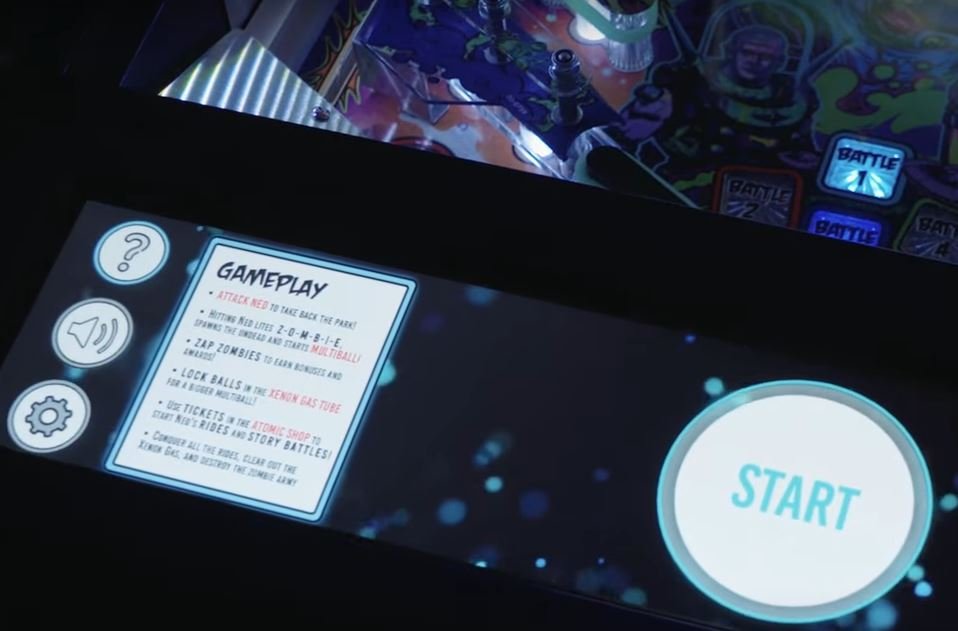

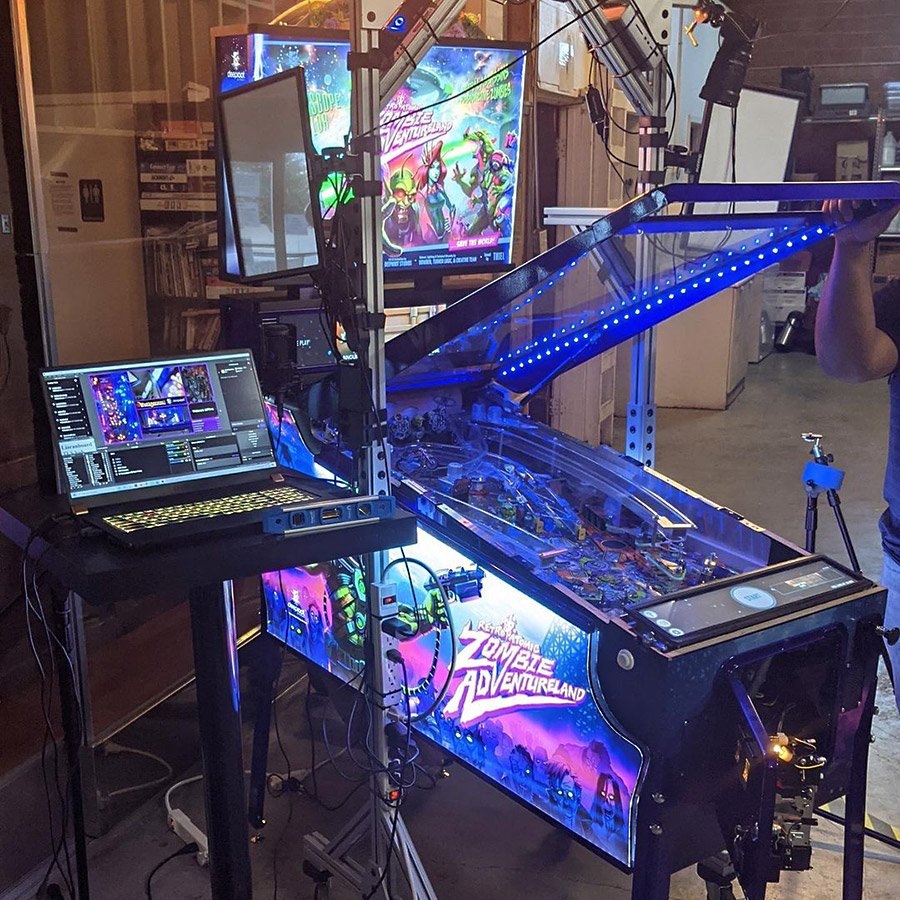

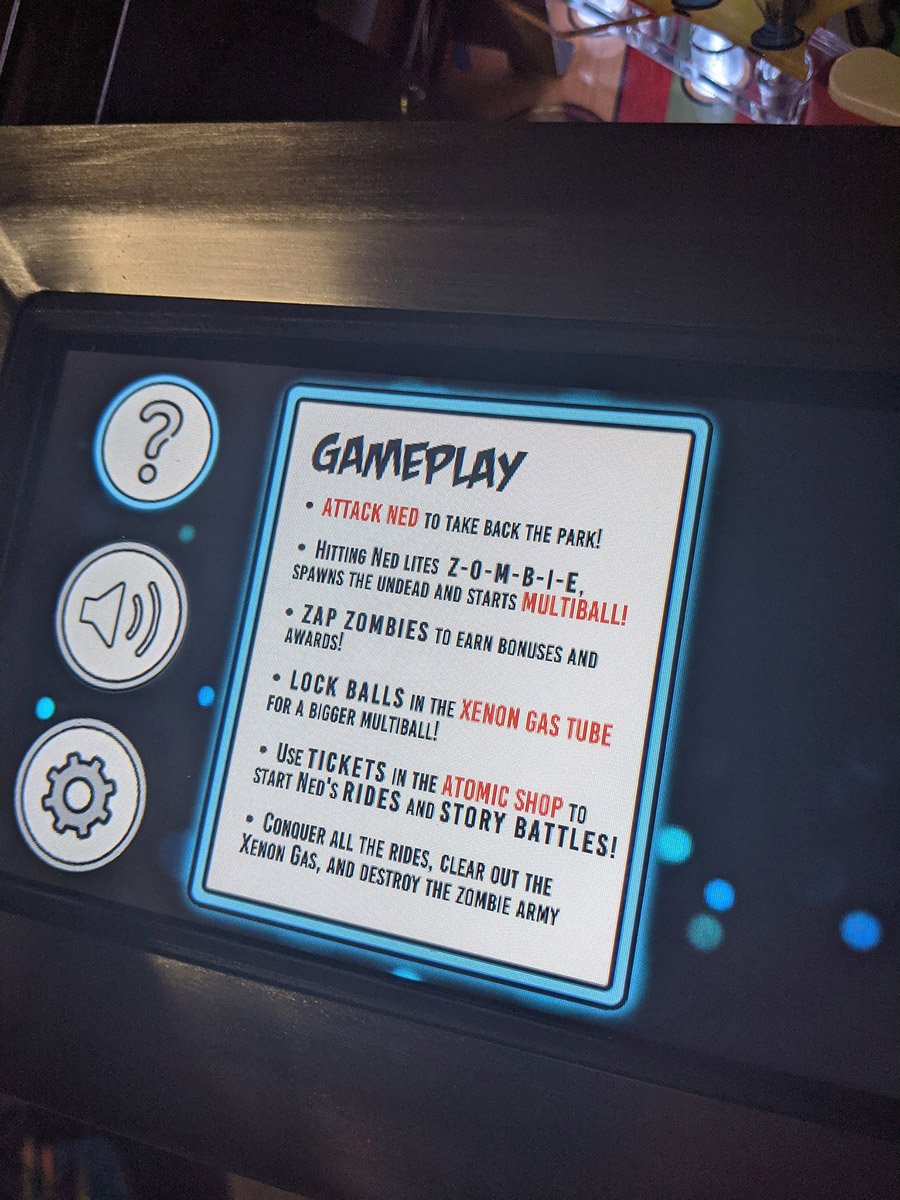

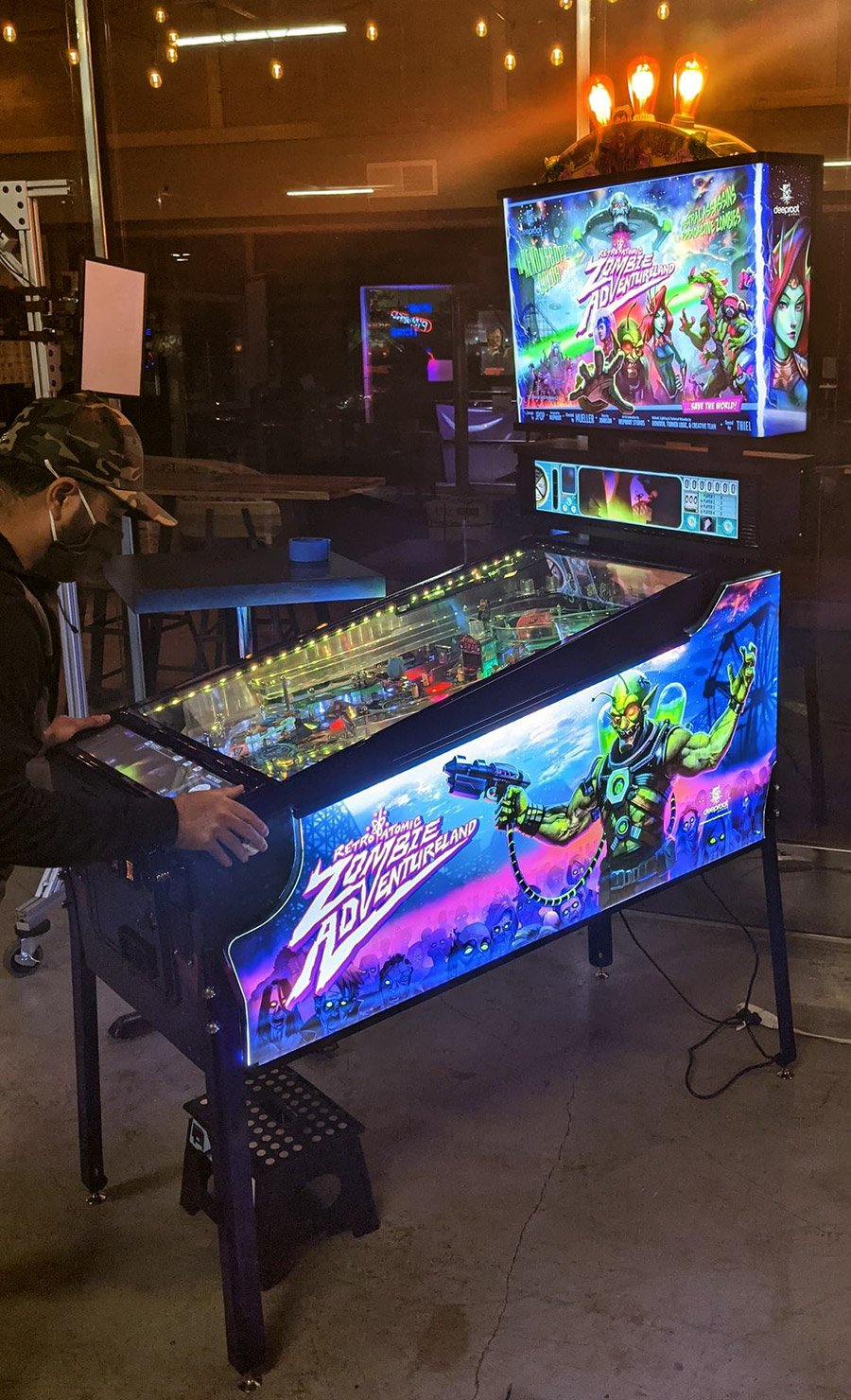

In 2013, no machine had been delivered but John, who had no doubts, launched Alice in Wonderland. Here it is again, his youthful passion! We gain one more degree of abstraction as fans only had a few artworks and a flyer to position themselves.






But that’s not all! In 2014 he also said he was working on a design based on the band Kiss, hoping his draft would catch the eye of the right holders. And he said he was thinking about other concepts.
You could say it: our man had lost his footing, investing in premature projects, and worse, communicating about them. The attitude of the customers who had paid the deposits oscillated between anger and concern. Attempts to reassure them, such as a blog about the progress of the work, were paltry or clumsy.
The end of Zidware
What had to happen, happened: in May 2015, Popadiuk announced that he had no more cash and therefore could not finalize his Magic Girl prototypes, let alone manufacture them. He said the only hope for saving Zidware would have been for a millionaire investor to come to his rescue.
But clear-headed people soon realized that in addition to financial resources, a real manager would have been needed and our designer would have been relegated to his original job. What’s more, the rescuer would have looked like a patron, because the business was so bad that it could not have become profitable again.
Later Popadiuk said that he was sorry for being a bad businessman. This is called a false confession. By saying this, he puts himself back into his misunderstood genius status.
Nevertheless, he half-admitted to underestimating the importance of the team that gravitated around him in the Bally/Williams days, and took care of turning his ideas into real products that actually went to customers.
The extent of the industrial disaster was finally revealed when a group of fans tried to finalize the Magic Girl pinball machine. After a serious, yet quick assessment, the leader of the group announced in June 2015 that the effort and the amount of money needed was too great. Clearly, Popadiuk had oversold the level of completion of his machine.
Finally, a collective of buyers sued the Popadiuk couple, seeking to recover their pre-orders.
American Pinball’s rescue attempt
In 2016, Dhaval Vasani was a savvy industrialist when he got into the pinball business by setting up American Pinball. So the alliance with Popadiuk seemed fitting. The designer would design a pinball machine for the new manufacturer, while the manufacturer would produce the Magic Girl games that Popadiuk owed the plaintiffs.
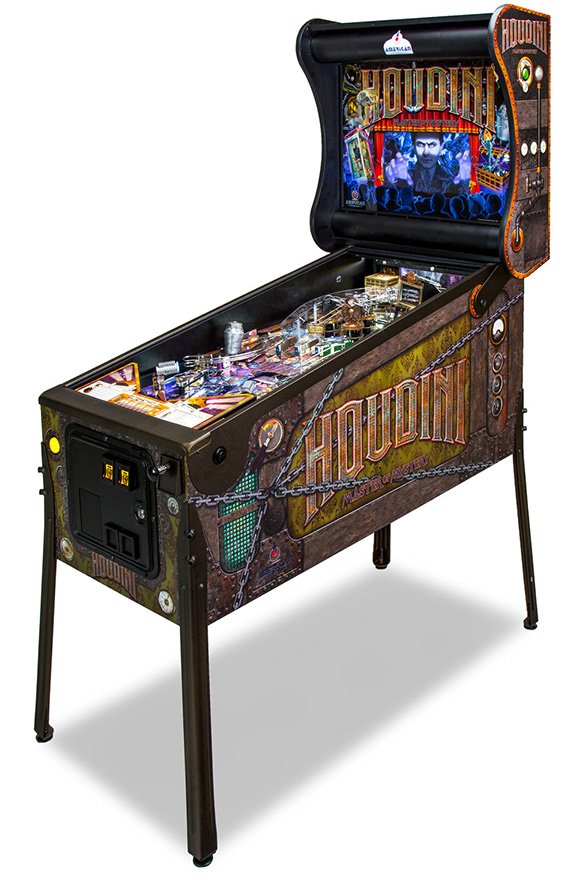

The new machine was to be licensed to Houdini, the magician (more magic!) and Popadiuk took on the task. At the same time, American Pinball delivered a few machines to Zidware customers, giving preference to those who had filed complaints. They were accompanied by a note stating that the products were in accordance with the designer’s specifications, implying “if it doesn’t work, it’s not our fault”! A useful precaution, since the pinball machines were clearly not functional.
The deal didn’t last long: the Houdini design looked like a poor man’s Magic Girl, and unfinished. Vasani called it a day and started from scratch, finally producing Houdini Master of Mystery.
The most amazing thing about this episode is that American Pinball recovered from this difficult start and went on its way. So don’t listen to those who spit on the businessmen, because without them there would be nothing but non functional prototypes.
The debacle with deeproot
In 2017, John Popadiuk partnered with a smooth talker named Robert J. Mueller, an investment advisor. He had not set foot in the pinball industry and promised to revolutionize the market.
The goal was to take over the production of the three endangered Zidware licenses, starting with Retro Atomic Zombie Adventureland. And everyone almost believed it, even at Pinball Mag. But as time went by, the delays kept piling up. The pandemic that spread in 2020 gave the benefit of the doubt to the young deeproot company, which had found a ready-made excuse to justify its last delays.
In the summer of 2021, the federal court of San Antonio sounded the end of the party: it summoned Mueller in justice, for having diverted the investments which were entrusted to him within the framework of his activities of council. He financed his marriages, divorces, vacations, his daughter’s education… And deeproot pinball!
More over, Mueller used the “Ponzi pyramid” technique: paying his oldest clients with the money of the latest ones, counting on a constant growth of his clients.
Once again, unfortunately, the prototypes presented at the end of 2020 were only a smoke screen, which masked the fact that no production had been started. The court’s verdict is still pending.
The responsibility of John Popadiuk in the deeproot case
The designer is not implicated in the misappropriation cases, which go beyond the framework of deeproot pinball. But one can’t help but wonder how the team working at the manufacturer could be unaware that no real production was launched. Here is what was left at the auction of deeproot’s equipment in early 2022: a few industrial machines, a few parts, a single prototype, all far too new to suggest that people actually worked here for so many years.
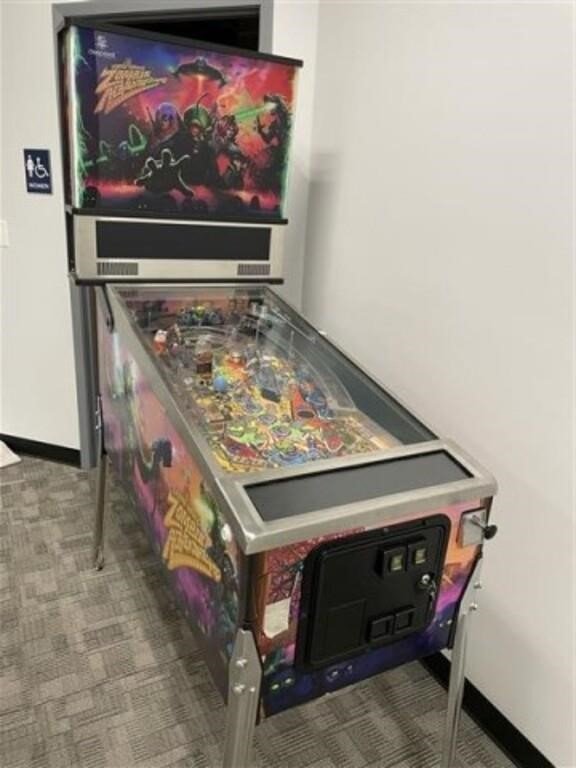





John Popadiuk: a mixed bag
I love euphemisms like this title!
Clearly John Popadiuk created some great machines in the 90s, still appreciated today. Nevertheless, he was surrounded by an ultra competent and numerous team, financed by a comfortable number of sales and a sustained rhythm of marketing.
Outside of this very specific environment, which will probably never occur again, the designer was not a business owner, and probably showed too much ego to make reasonable choices when there was still time.
But discernment is not his forte, as he tried to sue the plaintiffs for $100,000. The judge dismissed his case.
In short… Let’s keep in mind these 4 years of glory where he was successful and let’s draw some lessons from the rest of the story:
- Have respect for manufacturers who keep their commitments
- Never, ever, pay money for a blind pre-order, especially with new players
- Be wary of industry players who promise the moon, when they have not yet demonstrated anything
- Do not forget that designing and delivering a product is a collective effort. No one man, in name only, can be a guarantee
- Finally, let’s applaud this duo who managed to finalize the Magic Girl pinball machine
If you are interested in the finalized machine, our sources tells us that you will have to pay $60,000… It shows that John Popadiuk’s aura still has a value.
Sources for the article on John Popadiuk
To write this article, we turned the Internet upside down. Here are the main sources if you want to make your own opinion :
- https://en.wikipedia.org/wiki/John_Popadiuk
- https://pinside.com/pinball/machine/john-popadiuk
- https://www.linkedin.com/in/johnpopadiuk/
- https://gamecenter.nyu.edu/three-questions-with-john-popadiuk/
- https://www.youtube.com/watch?v=G8-1rDcYvOo
- https://www.youtube.com/watch?v=R1JOit2N3x0
- http://www.thepinballblog.com/2009/07/pinball-heroes-john-popadiuk.html
- https://www.multibille.fr/wiki/R%C3%A9paration_Williams_Pinball_2000
- https://www.pinballnews.com/news/americanpinball.html
- https://www.multibille.fr/wiki/American_Pinball
- https://www.popsci.com/curious-story-magic-girl-would-be-greatest-pinball-machine-all-time/
- https://www.engadget.com/2011-10-25-ben-heck-gets-into-the-pinball-business-for-real-pre-orders-beg.html
- https://www.expressnews.com/business/local/article/SEC-San-Antonio-lawyer-investment-funds-Deeproot-16429262.php
